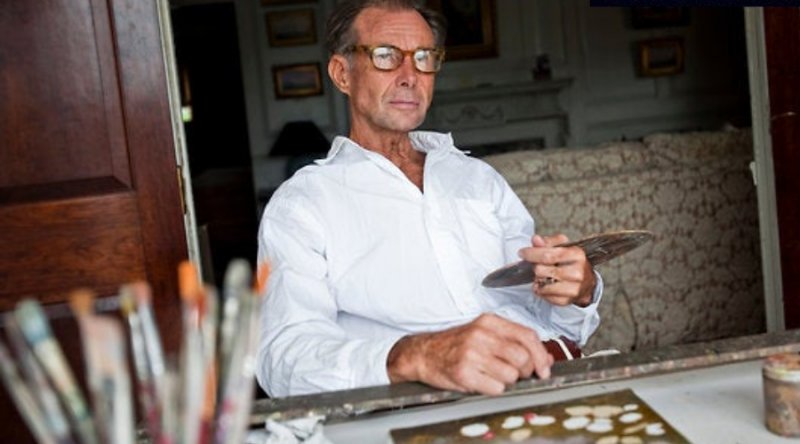MADEIRA BEACH, Fla. — For nearly three decades Ken Perenyi made a small fortune by forging the work of 18th- and 19th-century artists like Martin Johnson Heade, Gilbert Stuart, and Charles Bird King.
In 1998, the U.S. Federal Bureau of Investigation showed up at Mr. Ken Perenyi home, asking about paintings he had sold at Christie’s and Sotheby’s, purportedly by maritime artist James E. Buttersworth, but they were actually his own meticulous works.
In the years that followed, he says, the FBI continued to watch him closely at his bayside bungalow. They tracked his work and where it sold, as well as talking to his friends and associates. Ken Perenyi was never prosecuted, but the scrutiny prompted him to develop what he calls “a new business model”: selling his fake oils as genuine reproductions of great masterworks.
In the present day, they are purchased by Palm Beach decorators, antique dealers, professionals and business executives who want the look of cultured gentility without the price tag.
During his career as a con man, he realized that the life he knew and loved was over. A Ken Perenyi forgery once sold at auction for more than $700,000, but now he sells nearly identical works for as little as $5,000. Art-world equivalents of cubic zirconias with a three-carat weight that can be displayed like a Tiffany diamond.
Who sells them as authentic?
During the first few years of marketing and selling his paintings legitimately, Mr. Ken Perenyi, 63, said he could not tell where his paintings ended up or what people did with them. Behind him hung three fake Buttersworth yachts, similar to the yachts that attracted the F.B.I.’s attention in the first place. “I only sell to people I know today, and I have an established clientele.”
Andy Warhol bought one of his forgeries, a John F. Peto, from one of his forgeries, he says. He claims those forgeries enabled him to live an extravagant lifestyle, which included European travels, restaurants, and Versace couture. He claims the forgeries brought him into contact with mob enforcers and lawyers, including Roy Cohn and Andy Warhol.
He discusses his exploits in a book he will publish next month, “Caveat Emptor: the Secret Life of an American Art Forger” (Pegasus Books), which has been optioned by RKO Pictures. The book is being marketed as a confession, and David Perenyi, who is candid in discussing his life as a swindler, can rest assured that his forgeries have passed the statute of limitations.
The F.B.I. declined to comment on the accuracy of his account because the case file had not been closed, despite being inactive.
A lawyer vetted the manuscript at Pegasus, according to Claiborne Hancock, publisher. As a dealer, Mr. Ken Perenyi also consigned for auction some works he had produced, but he had actually consigned them to auction.
The manufacturer estimates that hundreds of Perenyi’s fakes remain in circulation. A few times a year he comes across one (“It’s like bumping into an old friend”) in an auction catalog or a magazine. He said he missed the thrill of fooling the experts. It was my favorite sport.
Neither Sotheby’s nor a spokesman could be reached for comment. It was pointed out by Christie’s that a work Mr. Perenyi claims as his own, an oil painting of two hummingbirds attributed to Heade and sold in 1993, is in the artist’s catalog raisonné, which is a definitive listing of all of his works. In response to Mr. Perenyi’s claim, Harvard Art Museums curator Theodore E. Stebbins Jr. said he would need to re-examine the work if Mr. Perenyi’s account were credible.
While the paintings have the artist’s signature, Mr. Perenyi’s legal business is different from his criminal one in that he makes it clear they are reproductions instead of originals. Someone is responsible for fraud only if they actively misrepresent something as an original.
He still takes great pride in his ability. There is no one who is capable of doing what he does.
In Europe, there is. As well as selling “genuine fakes,” British forger John Myatt works for a chain of galleries owned by a British publishing company. He spent four months in prison in 1999. Fakes created by top-tier artists like Mr. Myatt and Mr. Ken Perenyi can command a high price. Among his reproductions, which feature carefully aged frames, canvases, and backings, Mr. Perenyi’s prices range from $2,500 for a small Heade-signed hummingbird to $30,000 for a large Pannini-inspired Roman vista.
Many factors attract collectors to authentic paintings, including the artist’s vision, a venerable reputation, investment potential, and the ineffable mystique of authenticity. Fake designer goods satisfy another type of desire: aesthetic appeal at a fraction of the cost.
The Palm Beach socialite Nancy Telese says she has some of Mr. Ken Perenyi paintings mixed with other works of art. Her collection of his work includes Heade, Picasso, Modigliani, and Miró.
The paintings are much less expensive than a real painting, Ms. Telese said. “But I thought his work was at least as good as theirs.” His works were so detailed and beautiful. These are similar to the museum pieces I’ve seen around the world.”.
She said the “Picassos” will leave viewers gasping. The works aren’t usually asked if they are real, but if they are, she answers, “I say they are responses.”
Ken Perenyi says his clients don’t want to talk to reporters because they present his works as authentic.
Mr. Perenyi’s work is sold at Trinity Gallery in St. Petersburg, Fla., whose owner, Allan Abrams, said the majority of buyers are professionals who have always wanted to own a painting by certain artists. Impressionist works and nudes are the gallery’s best-selling items, he said, who requires buyers to sign a receipt attesting that they know they are buying a copy.
Perenyi’s own home, a replica of a Nantucket saltbox cottage, contains some of his favorite works, including cabin scenes by William A. Walker, a Stuart painting of George Washington, and horses by John F. Herring Sr.
While we were interviewing him, he pulled out a few large, blue plastic tubs and took their lids off. In one case, tiny framed pictures in the style of Canaletto and Pannini’s views of Venice decorated the walls in a manner similar to those of Guardi, a rival of Canaletto and Pannini. The miniatures were sold to the British nobility during Grand Tours. The paintings Mr. Perenyi has made are stored in secure storage units nearby, he says.
Mr. Perenyi spread half a dozen of his Guardi replicas across the living room floor. He explained that he developed his artistic technique on his own and learned the forensics from working for a restorer and a frame maker back in his 20s. He figured out how to simulate the telltale signs of age through extensive research and trial and error, including spider-web cracking in the paint, tiny holes left by fly droppings, and the slimy green appearance of old varnish under ultraviolet light. In 1994, Sotheby’s sold a Heade-style passion flower for $717,500 as a new discovery. He has a copy displayed on his fireplace mantel.
Mr. Ken Perenyi sees himself as the spiritual heir to the artists he copies. “These men were businessmen,” he said. They made multiple variations of a painting and had other artists work in their studios to duplicate it.
I am convinced that if they were still alive, these artists would be grateful to me, he said. His viewpoint is that he has a deep understanding of and appreciation for their work.
The horse’s coat was sheen while he stood over one of his Herrings and the jockey’s face was articulated in crystal clarity. The artist is sure Herring would be proud to sign this painting with his name, he said without trying to flatter himself.

